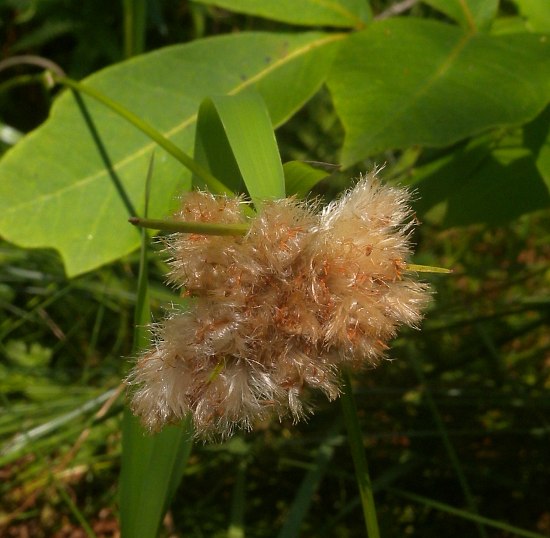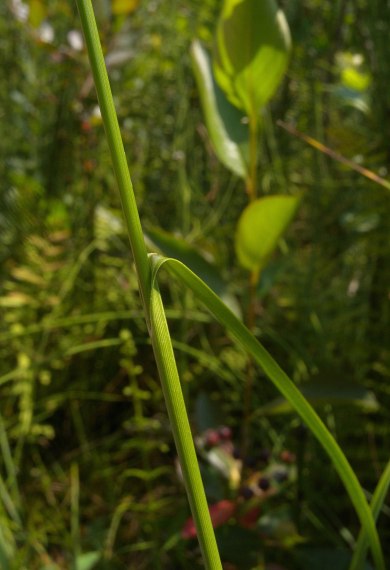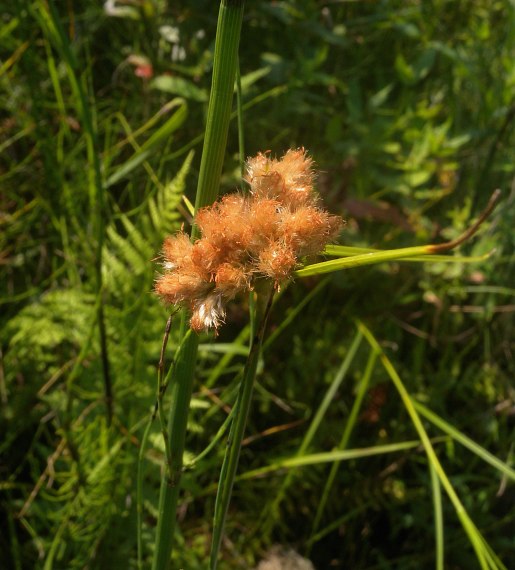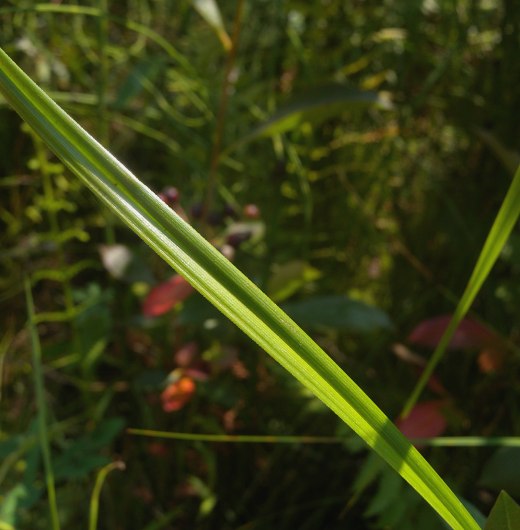
Each floret consists of a single stamen and an ovary with a tripartite style; 6 or more hair-like bristles originate from the base of the ovary, providing the spikelet with a hairy appearance. Depending on the stage of development, these bristles are reddish brown to light brown (rarely all white); they become longer as the spikelets mature. The peduncles of the spikelets are short (about 2–8 mm. in length). Directly underneath the cluster of spikelets, there are 2–5 spreading leafy bracts of variable length (½–6"). The blooming period occurs from mid-summer to late summer, lasting 2-4 weeks for a colony of plants. The florets are cross-pollinated by the wind. Afterwards, the hair-like bristles of the spikelets become twice as long, extending to about 12-20 mm. in length. Mature achenes are 2.5–4 mm. long, oblongoid-ellipsoid in shape, somewhat 3-angled, and brown to black. The hair-like bristles of the achenes help to distribute them by wind or water. The root system is fibrous and rhizomatous. Clonal offsets are occasionally produced from the rhizomes. Sometimes colonies of plants develop at favorable sites.

Cultivation: The preference is full or partial sun, wet to consistently moist conditions, an acidic soil with abundant organic matter, and cool weather. This perennial plant is very winter-hardy.
Range & Habitat: Tawny Cotton Grass (Eriophorum virginicum) is rare and state-listed as 'endangered' in Illinois, occurring in only 2 counties in the NE section of the state, where it is native (see Distribution Map). Tawny Cotton Grass is widely distributed in NE USA, the Great Lakes region, adjacent areas of Canada, and along the Appalachian Mountains. Illinois lies along the southwestern range-limit of this species. Habitats consist primarily of shrubby bogs, where there has been some accumulation of peat. In Illinois, this is a very conservative species that is found only in high quality natural areas. It is more common in boreal areas further to the north where bogs are more abundant.

Faunal Associations: An aphid that was introduced from Europe, Ceruraphis eriophori, feeds on the sap of cotton grasses (Eriophorum spp.) during the summer (Blackman & Eastop, 2013). A widely distributed seed bug, Cymus discors, has been found in the seedheads of cotton grass; it is known to feed on the seeds of bulrushes and other sedges. In boreal areas, the caterpillars of a butterfly, Oeneis jutta (Jutta Arctic), feed on these plants (Bug Guide at www.bugguide.net, accessed 2017). The foliage of cotton grasses is eaten by a variety of mammalian herbivores, including such domesticated animals as cattle and sheep, and such wild animals as the American Moose, White-tailed Deer, American Bear, and Canada Goose (Innes, 2014; Romain et al., 2013; Morris, 2014). In northern boreal areas of Canada, the diet of Tree Sparrows (Spizella arborea) consists primarily of the seeds of cotton grasses and sedges (Carex spp.); see West (1973). It is likely that other birds also feed on the seeds of cotton grasses.

Photographic Location: A shrubby bog in Lake County, Illinois.
Comments: Notwithstanding its common name, Tawny Cotton Grass (Eriophorum virginicum) is actually a sedge, not a grass. It is easily distinguished from other cotton grasses (Eriophorum spp.) by the brownish hairs of its seedheads and the relatively late time of year that they develop (typically during late summer). In contrast, other cotton grasses develop their seedheads during late spring or early summer, and the hairs of their seedheads are white. Tawny Cotton Grass can also be distinguished by the solitary stamens of its florets and the multiple veins on the scales of its seedheads. Other cotton grasses in Illinois have florets with three stamens and single-veined scales. As a group, cotton grasses are very ornamental because of the hairs on their seedheads, but they have more stringent requirements for cultivation than most plants.